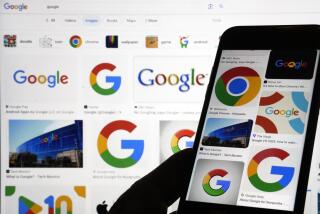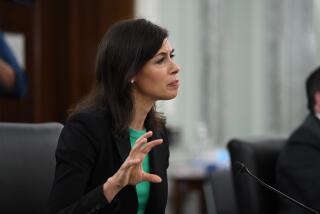Plan for Spectrum Is Making Waves
- Share via
WASHINGTON — As demand for wireless services surges, the federal government is weighing whether to wrest valuable swaths of the public airwaves from the exclusive use of television broadcasters and make them available to technology companies.
The proposal is part of a major policy shift backed by the Bush administration and the Federal Communications Commission, which want to open more of the crowded broadcast spectrum to emerging technologies such as the popular wireless networking standard known as Wi-Fi.
The administration and the FCC also want to speed the much-delayed transition to digital television by taking away spectrum from broadcasters and other users that are not making “efficient” use of it. For example, some companies use the frequencies assigned them rarely -- or not at all.
“This is their wake-up call,” said Michael D. Gallagher, an acting assistant Commerce secretary who oversees telecommunications policy for the Bush administration.
The policy shift reflects the growing influence of tech companies in Washington. It has angered broadcasters, which ridicule the ideas as “unrealistic,” saying they would “wreak havoc” on the tightly regulated spectrum. Technology firms say they need greater access to airwaves that support everything from instant text messaging on the subway to wireless laptops at Starbucks.
Television airwaves are particularly prized by purveyors of wireless devices because they can more easily pass through walls and other obstructions than the unlicensed portion of the spectrum, which is choked with 400 million cordless phones, microwave ovens, garage door openers and other electronic gadgets.
“The growth in wireless is beginning to have a real impact on policymakers,” said lawyer Greg Staples, who is leading a project to bring free Wi-Fi service to the National Mall in Washington.
In 1997, broadcasters were given $70 billion worth of spectrum to provide digital television by 2006. In exchange, they pledged to return their existing analog TV channels, which were to be auctioned off to wireless service providers.
Few believe digital television will be widespread enough in two years to end analog transmissions. The Bush administration and FCC Chairman Michael K. Powell have made it clear that they are frustrated by the slow rollout.
The first step toward accelerating it came this spring, when the FCC’s media bureau announced support for a plan that would count cable and satellite TV subscribers toward the audience threshold Congress set to trigger the digital transition. Lawmakers decreed that once 85% of TV viewers in a local market could receive a digital TV signal, broadcasters had to turn off analog service and return the channels to the government.
Broadcasters protested that such a quick switch would cut off millions of viewers without cable or satellite service and the expensive digital TV tuners required to get the new channels.
The FCC is finalizing another proposal drawing broadcasters’ ire: The agency’s staff next week is expected to recommend that the FCC consider allowing wireless users to share the unused “white spaces” separating television channels 2 through 51. Many broadcasting services are separated by the spaces, small amounts of spectrum intended to minimize interference. But because engineers have improved transmitters and receivers, white spaces can often be used by lower power services without causing interference, FCC officials say.
Meanwhile, broadcasters and the wireless industry are bracing for spectrum recommendations that the Commerce Department is expected to deliver to President Bush later this month. The report is expected to urge federal agencies and commercial users to utilize the airwaves more efficiently or risk having their spectrum reallocated.
Dean Goodman, chairman of Paxson Communications Corp., a West Palm Beach, Fla., firm that owns 61 television stations, said the proposals had “the potential to wreak havoc on the spectrum.... We are strongly opposed to any modifications.”
The National Assn. of Broadcasters and five other broadcast industry groups have sent a letter to Powell blasting the FCC digital TV proposal, saying it would be “to the detriment of consumers and contrary to” federal law.
Broadcasters aren’t uniformly opposed to shifting to other airwaves. But even those willing to move some of their operations are driving a hard bargain.
Earlier this month, the NAB and the Assn. for Maximum Service Television joined cellphone provider Nextel Communications Inc. in proposing that TV stations use airwaves on a different part of the spectrum for electronic news gathering. The deal, part of a plan to resolve interference with public safety communications gear, came together after Nextel agreed to pay $512 million to move the service, which is used to transmit video footage between the studio and remote locations.
Nextel could then use the spectrum vacated by broadcasters for cellular phone service without causing as much interference with police and fire radios. The proposal would need approval from the FCC.
The shift on spectrum policy reflects the Bush administration’s desire to set the groundwork for the next revolution in communications: wireless, high-speed Internet access.
Emerging wireless technologies make news, entertainment, e-mail and other diversions accessible from city parks and rural cabins. The field has attracted more than $4 billion in venture capital since 1999.
Over the last two years, the Commerce Department’s Gallagher has pushed to free up nearly eight gigahertz of spectrum -- more than 40,000 times the amount allocated to cellphone use -- for Wi-Fi and so-called ultra-wideband use.
“The technology is so easy to use and so low cost that wireless broadband is going to be pervasive,” said Ron Sege, president and chief executive of Tropos Networks, a San Mateo, Calif., company that sells Wi-Fi equipment. Sege said it cost his company just $3 to serve a wireless customer compared with five to 10 times that amount for cable and telephone companies to deliver wired broadband service.
The government’s aggressive approach to wireless reflects the growing influence in Washington of tech firms, which have increased their lobbying presence in the last three years. The shift has put the broadcast industry -- which for decades has been among the most powerful lobby groups in Washington -- on the defensive.
Broadcasters face “a lot more powerful interest on the other side now,” said Peter K. Pitsch, an Intel Corp. lobbyist. “If you look at the information technology industry, two or three years ago we were almost nowhere when it came to spectrum debates. Now, we are right in the middle of things in a big way.”






